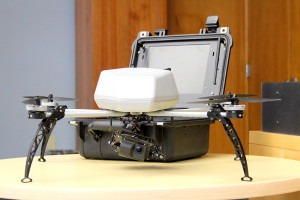
of a drone at the Feb. 14 meeting of the Alameda
County Board of Supervisors.
It weighs four pounds, has a four-foot wingspan, transmits real-time video while floating upwards of 400 feet in the sky, and could be coming to Alameda County.
Small Unmanned Aircraft Systems, commonly referred to as drones, are smaller, quieter and cheaper than helicopters, which is why the Alameda County Sheriff’s department wants to use a $30,000 grant from the California Emergency Management Authority to purchase “one or two.”
“The development of a small unmanned aircraft system program, the first of its kind in the state of California, can enhance public safety in Alameda County and save lives,” Captain Tom Madigan of the Sheriff’s Department said during the Feb. 14 public hearing of the Alameda County Board of Supervisors.
The sheriffs presented their plans before the county’s public protection committee and a room packed full of activists, citizens and journalists. Those plans included the use of drones for a wide range of missions, including crime scene documentation, fire, search and rescue, bomb detection, hostage situations and hazardous materials spills.
“If someone’s child was missing, and we had the opportunity to locate the child with the use of this device, it’s all worth it,” said Madigan, who several times emphasized the life preserving uses of the drones. “These devices can save the lives of first responders and also citizens of Alameda County.”
To hammer the point home, Madigan argued that a drone could have been used to locate kidnap victim Jaycee Lee Dugard or missing elderly Alzheimer’s patients, safely track and observe armed gunmen or roadside bombs, or assist firefighters in battling flames.
“We believe it would be incredibly helpful to provide a bird’s eye view of the scene and is useful for putting things into perspective,” said Madigan.
But for privacy advocate groups such as the American Civil Liberties Union and the Electronic Frontier Foundation, it is the sheriff’s intention to use the unmanned aerial systems for such a wide range of purposes that makes them uncomfortable.
“The policy as drafted essentially authorizes the sheriff to use the UAS whenever he wants,” said ACLU attorney Linda Lye. “That is too much of a carte blanche and should be limited … to search and rescue and other emotionally appealing uses that the sheriff has repeatedly emphasized.”
Lye argued that because drone technology is fairly new and sufficient legal framework to protect civil liberties does not yet exist such that “the potential for collecting information based on idle curiosity is opened up.”
“Small unmanned aerial systems are designed to operate surreptitiously, and that fundamentally changes the intrusiveness of the data collection,” said Lye, who added that a nude sunbather in their backyard would not be able to hear if a drone was overhead and would not know that their privacy was being infringed upon.
Lye also warned that the data collected by the drones could potentially be funneled into “fusion centers,” which gather intelligence about possible terrorism and funnel it to the Department of Homeland Security.
“This includes activities as innocuous as photographing bridges,” said Lye. “We live in the Bay Area, lots of people photograph bridges. That’s not a precursor to terrorism and that should not end up in a government fusion center.”
Captain Madigan downplayed privacy concerns by emphasizing the limitations of current drone technology, as well as the federal requirements that limit their capabilities.
The drones they are interested in, he argued, tend to only have 25-minutes of power before needing a recharge and must constantly be within 2,000 feet of the pilots.
Trevor Timm of the Electronic Frontier Foundation warned that the current limitations of the technology will likely not last long, and agreed with the ACLU that strong regulations must be enacted now in order to keep up with future developments.
“The technology will likely be obsolete in months, if it isn’t already,” said Timm. “This is why it is crucial to have rules of the road in place now, because once the door is opened, it will become much harder to restrict drone use in the future.”
Alameda County Supervisor and Chairman of the Public Protection Committee, Richard Valle, told The Pioneer he is wary of the potential to infringe on citizens’ constitutional rights through the use of drones.
“Rights to privacy are more important than the law enforcement’s need to do what they want to do,” said Valle. “I think that if you’re gonna use it for search and rescue, than the fire department can use it for search and rescue; that’s what the fire department does.”
Last year, Congress directed the Federal Aviation Administration to begin the process of safely integrating drones into United States airways by the end of 2015.
It is an FAA certificate of authorization that the Alameda County Sheriffs need in order to operate their class of drones in the county; whether or not they need the permission of the board of supervisors seems up to debate.
The disagreement over which powers the board has to stop the sheriff from purchasing the drones came after Supervisor Scott Haggerty, who is also on the Public Protection Committee, asked the county’s legal council if they even could stop the transaction if they wanted to.
“The board is not allowed to exercise that kind of supervisory authority in a way that would interfere or obstruct with the sheriff’s ability to make law enforcement decisions and take law enforcement actions,” said Donna Zeigler, Alameda County Counsel.
But ACLU spokesman Will Matthews told The Pioneer the board does have the authority to decide if the sheriffs can accept grant money to pay for the drones.
“The sheriff’s office is looking to accept a grant from [the California Emergency Management Authority] for the purchase of this drone, and so I think it’s certainly clear that the board of supervisors would need to approve the sheriff department’s accepting of this grant,” said Matthews. “What is less clear is whether or not the board of supervisors has the authority to approve line by line, the sheriff department’s budget.”
Zeigler later specified to The Pioneer that she was “not prepared to say they don’t have any way to stop the use of unmanned aerial systems in the county,” but because sheriffs are elected, they have specific statutory authority over law enforcement decisions.
Since the Feb. 14 meeting was a public hearing, no decision was made, and no additional meetings have been scheduled yet.
“The sheriff’s department has already reached out to us since the meeting last week,” said Matthews. “I think that they continue to exhibit a willingness and desire to be in contact with us and we certainly are willing to be in conversation with them. We’ll see where those conversations lead.”

















